FR-H-2-2020: Apple Tree Training and Pruning
Win Cowgill-Rutgers University, New Jersey Agricultural Experiment Station, USA
Jon Clements and Wes Autio-University of Massachusetts Amherst
Pruning and training apples is both an art and a science.
This age-old adage is still true in today’s modern high density orchard planting systems, however, the science is becoming more important to achieve peak production. Orchard productivity is a direct function of sunlight. Light management through proper pruning is the key to both high yield and high quality fruit production. Annual pruning is a necessary practice that maintains the profitability of an orchard. Knowing not only what must be cut but also what should be left uncut, and how the tree will respond is the art and science of pruning. The productivity of an orchard can be affected for the next three years by cuts made this season! It is critical for growers to know the result of management decisions made now, and understand what pruning technique will maximize profits in the long run.
This article will focus on large central leader trained trees. In higher density planting systems like tallspindle (2,200 plus trees per HA), there is greater need for detailed pruning and management of the trees. But for the sake of time we will just discuss important general rules of pruning as they apply to all orchard densities. For discussion on how to prune and manage tall spindle systems see: http://tallspindleapple.com/
The objective of tree training and pruning is to maximize the sunlight interception of the tree. This allows for light distribution within the tree canopy to maximize fruit quality for the current season and to provide fruit bud initiation for next season’s crop. Correct pruning and tree manipulation techniques must be done on an annual basis in the dormant season. On some varieties a “tune-up” in the summer assists with color formation. Growers should also keep in mind other important factors that justify the need for annual pruning: maintenance of tree height; building a structure to support crop load; and maintaining crop load by balancing vegetative growth with fruiting. Maintaining an open canopy with proper pruning and tree structure allows for penetration of pesticides and natural reduction of pest pressure (especially disease) due to better airflow with in the tree canopy.
Apple Tree Pruning and Training: A few basic rules for apple pruning
Also know as the Seven Rules- (complete them in order from 1-7)
- Remove the 2-3 largest limbs in the top 2/3 of the tree, based on their diameter (apply the 2-1 rule, see #2). If growing a free-standing, central-leader tree on more vigorous rootstocks, apply this rule to the upper half of the tree above any permanent scaffold limbs. (The bottom limbs are permanent scaffolds. After year 6-8 you may need to remove one of the permanent scaffolds, no more than one per tree per year as needed.) Big branches make big trees!
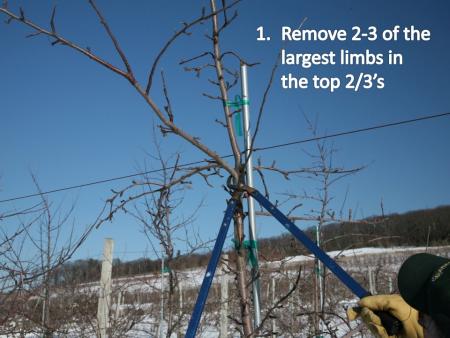
- Use the 2-1 rule, also called diameter based pruning. This is removing any scaffold branch or limb that is half the size or larger in diameter as compared to the central leader. A branch of this size chokes out the leader, not allowing the tree to reach optimal fruiting capacity. For high density systems like tall-spindle, use a bevel cut to remove these limbs.
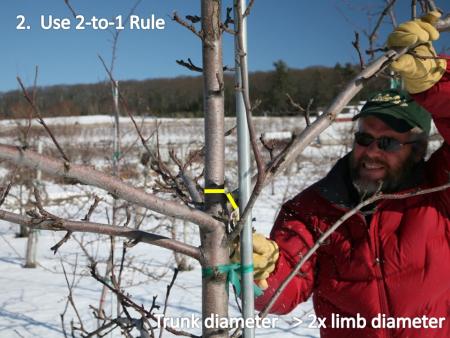
- Avoid heading cuts, remove the entire limb instead using a thinning cut. The one exception to this rule is a heading cut into newly planted trees (1 year old) that are to be grown to a free-standing or staked central-leader tree where strong, lower scaffold branching is desired in the bottom 1/3 of the tree. Heading is the exception if you do not have the use of the chemical 6-benzyladenine (6-Ba) to cause buds to break. Never head into upright, vigorous 1 year old wood!
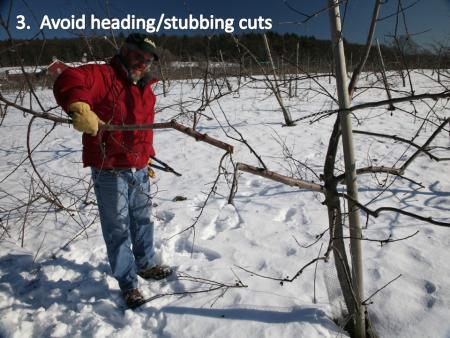
- Avoid complex branches on lateral limbs. We say simplify or de-complex the branch. If any branch divides cut off one side. Treat your lateral or scaffold branches like your leader, don’t let them divide and become forked. The more lateral or scaffold branches that are ‘simplified’ the more desirable they are to produce high quality fruit.
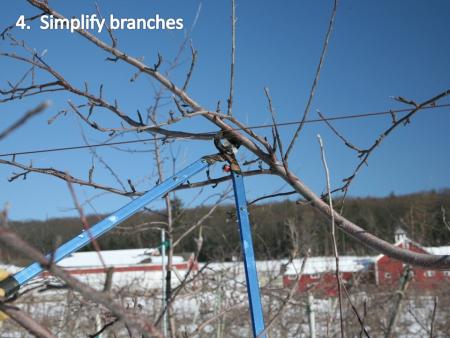
- Remove downward hanging (pendant) branches with a thinning cut.
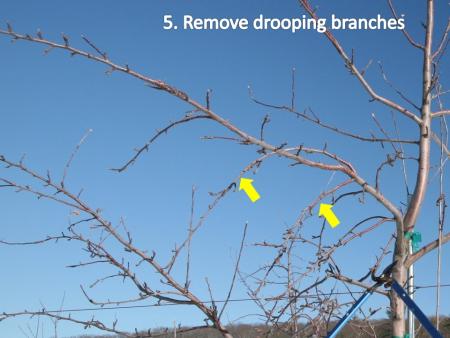
- Remove shoots that grow straight down or straight up from a lateral branch. Again, use a thinning cut, do not head! These include watersprouts.
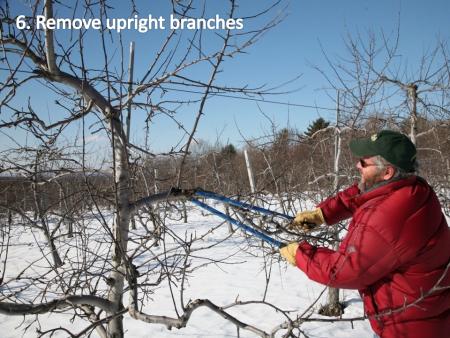
- Leave one shoot as a central leader, do not prune it. When the tree is mature and reached its natural height, it will fruiting, and will start to bend over. We use the term Crop and flop! That means when the leader bears fruit it will bend over (flop) and stop growing. You may then cut back to a weaker side branch to leave a wick (central leader) to maintain apical dominance.

There are two types of pruning cuts: heading and thinning cuts.
A heading cut is when a cut is made into a branch or the leader. Heading cuts stimulate excessive growth at the site of the cut, and will stiffen the wood that has been headed. This a typical practice when forming a central leader red delicious tree. It used to be referred to as the Don Heinke head and spread method.
Cutting into juvenile (1 year old) wood on a leader or one year growth on side branch will cause the 3-4 buds below the cut to break and grow vigorously. These fast growing shoots will cause excessive shade.
If tree growth suppression and the maintenance of a compact tree are the only desired effects from a heading cut, always cut an established limb or scaffold back into a mature, bearing side shoot or limb (2-3 year old wood). When making a heading cut never cut a limb back to blind wood (deadhead). The result will be tip dieback and wood rots will occur.
Renewal cuts, on the other hand, are cuts made at the point of branch origin. (Do not remover the branch collar) Most renewal cuts are intended to remove a branch that is no longer desirable because of vigor concerns or excessive crowding. Renewal cuts, on established trees, are always into mature wood and will not spark the vegetative regrowth that a heading cut will.
Maintain a balanced, “calm” tree
A goal of training and pruning apple trees is to result in a “calm” tree, i.e., one that is not “reacting” with a lot of vigorous, upright, non-fruitful growth. The choice of rootstock, tree spacing, annual bearing and the orchard system combined with the pruning techniques used will define whether you end up with a calm or “reactionary” tree. Using a lot of thinning cuts into older wood, instead of heading cuts, will help maintain a “calm” tree. You should strive for a balance of 1-, 2-, and 3-year-old wood in each tree. One-year old wood that is pencil-size in diameter and will produce new fruit buds in the current growing season (and may produce fruit with tip-bearing varieties on the terminal bud); Two year old wood will have a good amount of spurs and produce the best apples; and 3-year old wood will still produce fruit but is ready to make way for new fruiting wood using a thinning/renewal cut. In the ideal, you would have a nice balance of 1/3 each of 1-, 2-, and 3-year old wood. This applies to most all orchard pruning and training systems, although older, central-leader orchards will have to keep older structural wood (in addition to the central-leader) in lateral branches (scaffold limbs) to grow younger wood from and support the crop load.
Central Leader
The central leader is the tree’s natural regulator through its terminal bud and apical dominance. Tree performance and structure depends heavily on the manipulation of the central leader. Cutting into the central leader can cause a loss of growth control with that tree or delay cropping on non-bearing trees. Heading cuts on a central-leader can be done at planting when conditions warrant its use (except on slender- or tall-spindle trees where no cuts are made to the leader). Cutting the central leader should be the last resort to induce branching. If more branching is desired, other techniques such as notching, bending and the use of plant growth regulators (the PGR 6-benzyladenine (6-Ba) is very effective in stimulating buds to break). All of these methods may provide a better alternative than using a heading cut for inducing branching on the leader. Never cut into the central leader without knowing what the growth response will be!
Spur pruning is a good way to rejuvenate trees that are heavy spur bearers such as Red Delicious, Empire and Gala. A tree will produce its highest quality fruit on spurs that are 2-5 years old. Any spur that is older than 5 years reduces reduced quality fruit and should be removed. Some spur removal with pruning should be done every year on trees older than five years. The age of a spur can be determined by its size. Spurs on the bottom of limbs should be removed, as they will never produce high quality fruit. In addition, entirely remove older fruiting branches as discussed above with a thinning cut. Spur pruning initiates new shoot growth to produce new fruiting wood.
Although proper pruning is an overall dwarfing process, it is locally invigorating, stimulating vegetative growth at the site of the cut and the three to four buds below it. On a non-bearing tree, this type of stimuli causes the tree to remain in the vegetative mode, which delays cropping. For this reason, pruning young non-bearing trees should be minimized to correct major structural defects. Tree training and minimal corrective pruning of tree structure in the early non-bearing years will enhance the development of a new orchard ensuring the trees fill their space and begin fruiting.
Branch manipulation (training) plays the major role on tree structure and precocity (how quickly the orchard bears a crop) in the non-bearing years of an orchard. Only minor pruning should be done until after the tree crops for the first time. Once the tree has produced a crop, then it is time to begin an annual dormant pruning plan. Since we have not done much pruning up to this point, the tree may need a lot of attention (depending on variety) at this time (after 3-4 years of growth and non-fruiting). An excessive pruning at any single time, however, will cause an overstimulation of vegetative growth and a loss of balance within the tree between fruiting and vegetative growth. Excessive pruning can also cause sunburn to the fruit and wood of sensitive varieties such as Gala, Fuji and Golden Delicious. Finally, understanding the proper balance and relationship between fruit and vegetative growth will ensure quality production of annual fruit crops. No two systems or cultivars will respond in the same manner to all the techniques presented above, but understanding these procedures and their responses will help growers make the right cultural decisions.
More information
- Apple Tree Training and Pruning: A Few Basic Rules for Pruning. Win Cowgill, Jon Clements, Pedro Perdomo, and Wes Autio. Quick sheet instructions in English and Spanish, suitable for field use by pruners.
- "Training and Pruning Apple and Pear Trees." 1992. Chick Forshey, D. Elfving and B. Stebbins, Cornell. This is an excellent reference on apple pruning. It is a 166 page paperback that is out of print but can be obtained from Amazon as a used book. It contains a lot of theory on the why's of apple growth and pruning. Search for "training and pruning apple and pear trees" at http://www.amazon.com.
- Training and Pruning Apple Trees. 2015. Richard P. Marini, Extension Specialist, Horticulture, Virginia Tech. Reviewed by Gregory Peck, Assistant Professor of Horticulture and Extension Specialist, Alson H. Smith, Jr. Agricultural Research and Extension Center, Virginia Tech.
- The Vertical Axis Planting System. Steve Hoying, Terence Robinson, and Mike Fargione. Cornell University Cooperative Extension, Hudson Valley Lab and NYSAES.
- The Tall Spindle Planting System. Steve Hoying, Terence Robinson, and Mike Fargione. Cornell University Cooperative Extension, Hudson Valley Lab and NYSAES.
- The Slender Pyramid Planting System. Steve Hoying, Terence Robinson, and Mike Fargione. Cornell University Cooperative Extension, Hudson Valley Lab and NYSAES.
- Pruning Tip #1 - Start pruning after the New Year (YouTube video with Jon Clements)
- Pruning Tip #2 -- It's all about light (YouTube video with Jon Clements)
- Apple Tree Pruning. 2018. MassAggie presentation (PDF) by Elizabeth Garofalo, Jon Clements, and Wesley Autio
- Pruning Fruit Trees in the Home Orchard (C-108). William J. Lord and James F. Anderson. Department of Plant & Soil Scineces, Univeristy of Massachusetts. Outdated, but still useful and still available at UMass Extension Bookstore.